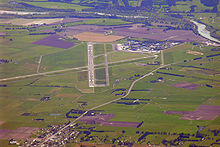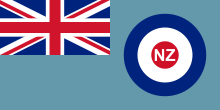- RNZAF Base Ohakea
-
Royal New Zealand Air Force Aircraft and Squadrons List of aircraft of the RNZAF and RNZN List of squadrons of the RNZAF Bases RNZAF Base Auckland RNZAF Base Ohakea RNZAF Base Woodbourne Other Royal New Zealand Air Force Museum RNZAF Base Ohakea 
IATA: OHA – ICAO: NZOH Summary Airport type Military Operator RNZAF Location Bulls, New Zealand Elevation AMSL 164 ft / 50 m Coordinates 40°12′22″S 175°23′16″E / 40.20611°S 175.38778°ECoordinates: 40°12′22″S 175°23′16″E / 40.20611°S 175.38778°E Runways Direction Length Surface ft m 09/27 8,021 2,445 Asphalt 09L/27R 1,887 575 Grass 15/33 6,998 2,133 Asphalt RNZAF Base Ohakea is an operational base of the Royal New Zealand Air Force. Opened in 1939, it is near Bulls, 25 km north west of Palmerston North in the Manawatu. It is also a diversion landing point for civilian aircraft.
Contents
Early days
An air base was originally proposed in the area in 1927, when Ohakea was selected as the most suitable site for a mooring mast for airships of the British Imperial Airship service.[1] It was proposed to build one mast for a demonstration flight, with the potential for expansion to a full airship base with three masts, airship sheds and hydrogen production. However, there was no point in going ahead with the development of the site without a commitment from the Australian Government to build masts to provide bases in that country. When the Australian Government declined to build masts, the New Zealand Government declined likewise.
1930s development
In 1935 the Labour government committed to an expansion of the military air service at the expense of the navy, seeing this as a way of reducing the total defence vote. At the end of 1935 the government accepted an air service expansion plan developed by RAF Wing Commander Ralph Cochrane.[2]
The plan called for several new bases, with a major development at Ohakea, which would be home to 30 Wellington bombers on order for the RNZAF. Two large hangars (now hangars 2 and 3) were authorised to house the aircraft, to be designed by the Department of Public Works chief design engineer Charles Turner. Turner decided to build the hangars as monolithic reinforced concrete structures because structural steel could not be obtained in sufficient quantities without delays, while concrete and reinforcing steel could be delivered immediately. The same limitation forced Turner to adopt concrete doors. The arched hangars spanned 61 metres, with a height of 18 metres. The expense of the steel centering was spread across four hangars, as another two similar structures were ordered for Whenuapai air base in Auckland. The two Ohakea hangars were completed in 1939, at a cost of about £76,750 each.
Ultimately, the Wellington bombers for which the hangars were built never arrived, as they were donated to Britain at the start of the second world war. However, the hangars have been in continuous use since their construction, and (re-roofed in steel) remain in use today.[3]
Military service
During World War II Ohakea was the RNZAF main training base for operational conversion on fighters, observers/navigators for medium bombers and air gunners. After World War II No 14, No 42 and No 75 squadrons were re-formed at Ohakea, and No.1 Repair Depot relocated from Hamilton.
Since the end of the war Ohakea has been the RNZAF's strike base, with Nos 14 and 75 Squadrons resident. A long-time resident, No 42 Squadron relocated to Whenuapai in 1984 to allow the reformation of No 2 Squadron to HMAS Albatross, Nowra, Australia in 1991. In 1993 RNZAF flying training previously carried out at Wigram by the Pilot Training Squadron and the RNZAF's Central Flying School moved to Ohakea. Also in 1993 a new aviation wing of the Royal New Zealand Air Force Museum was opened at Ohakea. Nos 14 and 75 Squadrons disbanded in November 2001, and No 42 squadron relocated back to Ohakea in January 2002. There are currently around 650 personnel based at Ohakea.[citation needed]
A plan to consolidate all RNZAF operations at Ohakea was abandoned in March 2009 as part of a change of policy on the part of the incoming National Government who chose to retain two operational air bases, Ohakea and Whenuapai, for use by the RNZAF[4]
Stationed units
- HQ Flying Training Wing
- No. 42 Squadron RNZAF (King Air B200)
- No. 3 Squadron RNZAF (Iroquois and Bell-47 Sioux)
- Pilot Training School (King Air B200 and CT-4E Airtrainer)
- RNZAF Central Flying School (CT-4E Airtrainer - shared with PTS)
- Expeditionary Support Squadron
Civilian functions
Ohakea is a secondary diversion airport for civilian Boeing 747s if both Auckland and Christchurch airports are temporarily closed. Ohakea does not have the facilities to process that number of passengers, so the aircraft must wait for either Auckland or Christchurch to reopen.
At about 21:20 on Thursday 3 May 2007 smoke in the cockpit of a Air New Zealand Boeing 737 forced it to make an emergency landing at Ohakea with more than 100 passengers on board[5], including several Members of Parliament.[6] Later that day a Boeing 747 landed after being diverted from a foggy Auckland Airport.
Ohakea has been the subject of a feasibility study into mixed-use military and civilian freight capability, which has included lengthening the main runway to accommodate the Boeing 747.[7]
References
- ^ Re: airship base
- ^ [Wright, Matthew, Kiwi Air Power: the History of the RNZAF, Raupo Publishing (NZ) Ltd, 1998, ISBN 0790006251, pp 25-29 ]
- ^ [Wright, Matthew, New Zealand’s Engineering Heritage 1870 - 2000, Reed Books (Auckland) Ltd, 1999, ISBN 0-79000690-1, pp 89-91 ]
- ^ http://www.scoop.co.nz/stories/PA0903/S00450.htm
- ^ "Transport Accident Investigation Commission (TAIC) Occurrence Report"
- ^ "Report reveals why plane was diverted". The Dominion Post. NZPA. 19 March 2008. http://www.stuff.co.nz/dominion-post/323678. Retrieved 5 November 2011.
- ^ [1]
External links
Categories:- Royal New Zealand Air Force bases
- Manawatu-Wanganui Region
- Airports in New Zealand
- Buildings and structures in the Manawatu-Wanganui Region
- Motorsport venues in New Zealand
Wikimedia Foundation. 2010.


